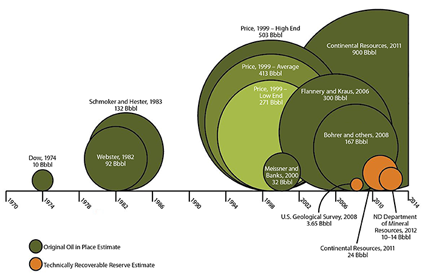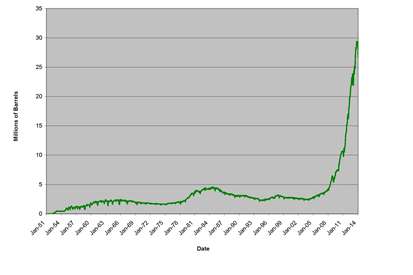Oil Production
According to the U.S. Geological Survey (USGS), the Bakken Formation is the largest continuous oil resource in the lower 48 states. Although the Bakken Formation is productive in numerous reservoirs throughout Montana and North Dakota, the Elm Coulee Field in Montana and the Mountrail County area of North Dakota were the first to benefit from modern, successful practices. 15
Bakken Formation Resource Estimates
The amount of oil in place (OIP, or total oil generated) in the Bakken Formation has been debated for decades. The estimates range from 10 to 500 billion barrels (Bbbl) of oil. The use of different methodologies is the greatest contributor to this extreme variation, along with data usage and available technology.
The first estimate, numbering approximately 10 Bbbl, was developed by Wallace Dow in 1974.8 Data at that time were limited, and this was the first publication to suggest the Bakken Formation was capable of generating very large volumes of oil. Academic studies followed in the early 1980s, and the number increased to 92 Bbbl3 and then 132 Bbbl9 by 1983. The availability of additional data largely influenced these results.
The largest (and most controversial) estimate was developed by USGS geochemist Dr. Leigh Price in 1999. 10 Price's manuscript was never formally published as he passed away before the paper completed the review process. Price estimated total oil in the Bakken to range from 271 to 503 Bbbl, with an average of 413 Bbbl. His study was based on the largest data set available at the time and incorporated methods that accounted for changes in the rock units over geologic time.
Using a smaller data set and a new computer modeling package, Meissner and Banks11 estimated 32 Bbbl of oil had been generated in the Bakken. Flannery and Kraus12 used a more sophisticated modeling program and a much larger data set to develop a much larger estimate of 300 Bbbl.
Based on an independent evaluation, the North Dakota Geological Survey (NDGS) currently believes approximately 167 Bbbl of oil that has been generated in the North Dakota portion of the Bakken Formation.13 This estimate is in line with the large estimates by Price and Flannery and Kraus.
Of that 167 Bbbl of oil, the NDGS estimates approximately 2.1 Bbbl is technically recoverable with early 2008 technology. 13 At about the same time and using different methods, USGS released an estimate stating approximately 3.65 Bbbl is technically recoverable from the U.S. portion (North Dakota and Montana) of the Bakken using 2008 technology. These numbers are also roughly in agreement and represent only 1%–2% of the oil that may be trapped in the formation.
Oil Recovery Well per Well
On an individual well basis, ultimate recovery from North Dakota wells ranges from 500,000 to 900,000 bbl per well, compared to 100,000 to 400,000 bbl per well in the Elm Coulee Field of Montana. Improved hydraulic fracturing technology including more fracturing stages has become a significant contributor to improved production. In addition, the productive reservoir section on the North Dakota side of the Williston Basin is thicker and more widely distributed, typical of an unconventional resource play. If the predictions prove to be accurate and are repeatable over a wide area, the Bakken would likely be the most prolific onshore oil play in the United States.



